|
|
|
|
|
Oil On
Canvas, Real Flavor of Old Masters
|
|

|
ARTWORKS
INDEX
A B C D E F G H I J K L M N O P Q R S T U V W X Y Z |
ARTISTS
INDEX
A B C D E F G H I J K L M N O P Q R S T U V W X Y Z |
|
|
| | |
|
|
|
|
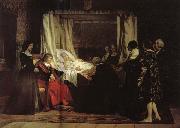 |
Eduardo Rosales Gallinas -- Click Here
|
|
Spanish , Madrid, 1836 - Madrid, 1873
|
|
|
|
|
|
 |
Dirck de Quade van Ravesteyn -- Click Here
|
|
Flemish painter 1565-1620 |
|
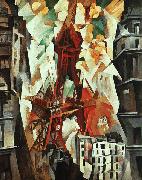 |
Delaunay, Robert -- Click Here
|
|
French Cubist Painter, 1885-1941
French painter, printmaker and writer. Taking Cubism as one of his points of departure, he first developed a vocabulary of colour planes only distantly dependent on observed motifs, and by the 1930s he had arrived at a purely self-sufficient language of geometric forms. He remained active as a theoretician until the end of his life, |
|
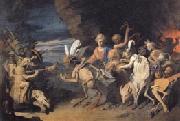 |
David Ryckaert -- Click Here
|
|
Flemish Baroque Era Painter, 1612-1661
was a Flemish painter. A member of the Ryckaert family of artists, he was born and raised in Antwerp, the city in which he conducted his career and in which he died. He was the son of David Ryckaert II, grandson of David Ryckaert I, and nephew of Martin Ryckaert. David Ryckaert was a pupil of his homonymous father; his work was influenced by the styles of Adriaen Brouwer and both David Teniers the Elder and David Teniers the Younger. Ryckaert is noted for large and often humorous genre pictures of farmers and landlords, and powerfully coloured still lifes. He also painted a range of other subjects, including religious pictures; his The Temptation of Saint Anthony (1650) is in the collection of the Palazzo Pitti in Florence. |
|
|
|
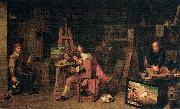 |
David Rijckaert -- Click Here
|
|
David Ryckaert III, sometimes called The Younger (2 December 1612 (baptised) - 11 November 1661) was a Flemish painter.
A member of the Ryckaert family of artists, he was born and raised in Antwerp, the city in which he conducted his career and in which he died. He was the son of David Ryckaert II, grandson of David Ryckaert I, and nephew of Martin Ryckaert.
David Ryckaert was a pupil of his homonymous father; his work was influenced by the styles of Adriaen Brouwer and both David Teniers the Elder and David Teniers the Younger. Ryckaert is noted for large and often humorous genre pictures of farmers and landlords, and powerfully coloured still lifes. He also painted a range of other subjects, including religious pictures; his The Temptation of Saint Anthony (1650) is in the collection of the Palazzo Pitti in Florence.
|
|
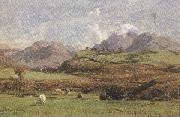 |
david farquharson,r.a.,a.r.s.a.,r.s.w -- Click Here
|
|
1840-1907
|
|
|
|
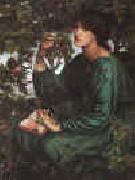 |
Dante Gabriel Rossetti -- Click Here
|
|
English Pre-Raphaelite Painter, 1828-1882
Rossetti's first major paintings display some of the realist qualities of the early Pre-Raphaelite movement. His Girlhood of Mary, Virgin and Ecce Ancilla Domini both portray Mary as an emaciated and repressed teenage girl. His incomplete picture Found was his only major modern-life subject. It depicted a prostitute, lifted up from the street by a country-drover who recognises his old sweetheart. However, Rossetti increasingly preferred symbolic and mythological images to realistic ones. This was also true of his later poetry. Many of the ladies he portrayed have the image of idealized Botticelli's Venus, who was supposed to portray Simonetta Vespucci.
Although he won support from the John Ruskin, criticism of his clubs caused him to withdraw from public exhibitions and turn to waterhum, which could be sold privately.
In 1861, Rossetti published The Early Italian Poets, a set of English translations of Italian poetry including Dante Alighieri's La Vita Nuova. These, and Sir Thomas Malory's Morte d'Arthur, inspired his art in the 1850s. His visions of Arthurian romance and medieval design also inspired his new friends of this time, William Morris and Edward Burne-Jones. Rossetti also typically wrote sonnets for his pictures, such as "Astarte Syraica". As a designer, he worked with William Morris to produce images for stained glass and other decorative devices.
Both these developments were precipitated by events in his private life, in particular by the death of his wife Elizabeth Siddal. She had taken an overdose of laudanum shortly after giving birth to a stillborn child. Rossetti became increasingly depressed, and buried the bulk of his unpublished poems in his wife's grave at Highgate Cemetery, though he would later have them exhumed. He idealised her image as Dante's Beatrice in a number of paintings, such as Beata Beatrix.
These paintings were to be a major influence on the development of the European Symbolist movement. In these works, Rossetti's depiction of women became almost obsessively stylised. He tended to portray his new lover Fanny Cornforth as the epitome of physical eroticism, whilst another of his mistresses Jane Burden, the wife of his business partner William Morris, was glamorised as an ethereal goddess. |
|
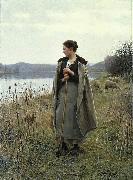 |
Daniel Ridgway Knight -- Click Here
|
|
(March 15, 1839 - March 9, 1924) was an American artist born at Philadelphia, Pennsylvania. He was a pupil at the Ecole des Beaux-Arts, Paris, under Gleyre, and later worked in the private studio of Meissonier. After 1872 he lived in France, having a house and studio at Poissy on the Seine.
Spring BlossomsHe painted peasant women out of doors with great popular success. He was awarded the silver medal and Cross of the Legion of Honor, Exposition Universelle, Paris, 1889, and was made a Knight of the Royal Order of St. Michael of Bavaria, Munich, 1893, and receiving the gold medal of honor from the Pennsylvania Academy of the Fine Arts, Philadelphia, 1893. His son, Louis Aston Knight (1873 - 1948), is also known as a landscape painter.
|
|
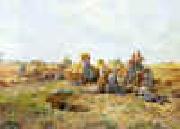 |
Daniel Ridgeway Knight -- Click Here
|
|
1839-1924
Daniel Ridgeway Knight Gallery
Daniel Ridgway Knight was born on March 15,1839 in Pennsylvania. He studied and exhibited at the Pennsylvania Academy of the Fine Arts, were he was a classmate of Mary Cassatt and Thomas Eakins. In 1861, he went to Paris to study at L'Ecole des Beaux-Arts under Cabanel, and to apprentice in the atelier of Charles-Gabriel-Gleyere. |
|
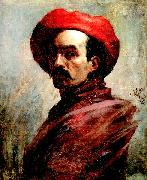 |
Cristobal Rojas -- Click Here
|
|
Cristobal Rojas (Cua, Miranda, 15 December 1857 e Caracas, 8 November 1890) was one of the most important and high-profile Venezuelan painters of the 19th century. Rojas's styles varied considerably throughout his life, and he displayed talents in painting that ranged primarily for dramatic effect, to works done in the Impressionist style.
Cristebal Rojas Poleo was born in the city of Cea in the Valles del Tuy to parents who worked in the medical profession. Part of his childhood occurred during the middle of the federal war (1859 - 1863) and Cea was particularly affected by the events of the war. He initiated studies under his grandfather, Jose Luis Rojas, who taught him how to draw and motivated him to improve. At 13 years old, his father died and he was forced to begin work in a tobacco factory in Cea to help support his family. In 1878, an earthquake devastated the Valles del Tuy region, and the Rojas faced poverty. As a result he moved to Caracas where he continued his painting studies, despite again having to work in the tobacco industry to support his mother and family.
In Caracas he attended classes by Jose Manuel Mauco at the Universidad Central de Venezuela. Between 1880 and 1882, he developed a keen interest in oils and displayed a primitive technique that would prevail in his later paintings such as Ruinas de Cea despues del Terremoto and Ruinas del templo de la Merced. During this time he became acquainted with the painter Antonio Herrera Toro, also coming under contract as Toro's assistant to paint Caracas Cathedral.
|
|
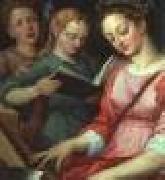 |
COXCIE, Raphael -- Click Here
|
|
Flemish painter (b. 1540, Mechelen, d. 1616, Brussels).
|
|
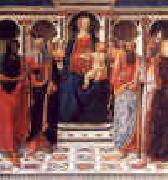 |
Cosimo Rosselli -- Click Here
|
|
Italian
1439-1507
Cosimo Rosselli Gallery
Born in Florence, at the age of fourteen he became a pupil of Neri di Bicci, and in 1460 he worked as assistant to his cousin Bernardo di Stefano Rosselli. A first youthful work of Cosimo mentioned by Giorgio Vasari is the Assumption of the Virgin altarpiece in the third chapel on the left of the nave in Sant'Ambrogio in Florence. In the same church, on the wall of one of the chapels, is a fresco by Cosimo which Vasari praises highly, especially for a portrait of the young scholar Pico of Mirandola. The scene, a procession bearing a miracle-working chalice, is painted with vigor and less mannerism than most of this artist's work. A picture painted by Rosselli for the church of the Annunziata, with figures of SS. Barbara, Matthew and the Baptist, is in the Academy of Florence.
Rosselli also spent some time in Lucca, where he painted several altar-pieces for various churches. A picture attributed to him, taken from the church of St. Girolamo at Fiesole, is now in the National Gallery of London. It is a large retable, with, in the center, St. Jerome in the wilderness kneeling before a crucifix, and at the sides standing figures of St. Damasus and St. Eusebius, St. Paula and St. Eustochium; below is a predella with small subjects. Though dry and hard in treatment, the figures are designed with much dignity.
The Berlin Gallery possesses three pictures by Rosselli: The Virgin in Glory, The Entombment of Christ, and The Massacre of the Innocents. In 1480 Rosselli, together with the chief painters of Florence, was invited by Pope Sixtus IV to Rome to assist in the painting of the frescoes in the Sistine Chapel. Three of these were executed by him The Destruction of Pharaohs Army in the Red Sea, Christ Preaching by the Lake of Tiberias, and The Last Supper. Rosselli's Sistine frescoes were partly painted by his assistant and son in law Piero di Cosimo, who was so called after Cosimo Rosselli. His chief pupil was Fra Bartolomeo.
According to Vasari, Rosselli died in 1484, but this is a mistake, as his is known to be living on 25 November 1506 |
|
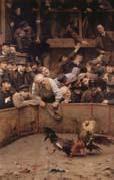 |
Cogghe Remy -- Click Here
|
|
Belgian , Mouscron 1854-Roubaix 1935
|
|
|
|
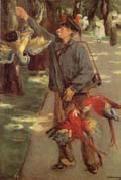 |
Christian Rohlfs -- Click Here
|
|
German Painter, 1849-1938
German painter and printmaker. He studied painting at the Kunstschule in Weimar (1870). Prolonged illness forced him to interrupt his studies, which he resumed in 1874 under Ferdinand Schauss (1832-1916) and Alexandre Struys (1852-1941). Through visits to Paris in the 1870s, he came into contact with the art of the Barbizon school, painting en plein-air on his return to Weimar. Under the influence of Struys he painted figurative works, such as Roman Builders (1879; Menster, Westfel. Landesmus.), and nudes in the tradition of academically enlightened Realism. In 1881 Rohlfs worked in a studio under Max Thedy (1858-1924). From c. 1883 he painted mainly landscapes with the approval of Ludwig von Gleichen-Russwurm (1836-1901), who was studying with Theodor Hagen (1842-1919), and was influenced in an indirect way by Albert Brendel (1827-95), who had taught at Weimar from 1875. He often chose formats that were unusually large for landscape paintings in this period, presenting landscape in a similar way to history painting. Atmosphere and light played an important role even in these early pictures, for example Sawmill at Ehringsdorf on the Ilm (930x780 mm, 1883; Weimar, Schlossmus.). From 1884 he worked as an independent painter. After 1885 colour became increasingly important for its own sake; light and shade were suggested purely by colour, which was applied in impasto spots and brushstrokes to create chiaroscuro values that determined the form, for example Wild Garden near Weimar (1888; Weimar, Schlossmus.). By the end of the 1880s he had developed an independent style parallel to Impressionist painting. When he saw works by Monet exhibited in Weimar in 1897, these corroborated his own efforts. |
|
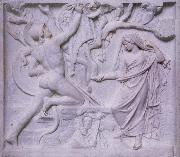 |
Christian Daniel Rauch -- Click Here
|
|
1777 Arolsen-1857 Dresden,was a German sculptor. Rauch was born at Arolsen in the Principality of Waldeck. His parents were poor and unable to place him under efficient masters. His first instructor taught him little else than the art of sculpting gravestones, and Professor Ruhl of Kassel could not give him much more. A wider field of improvement opened up before him when he removed to Berlin in 1797; but he was obliged to earn a livelihood by becoming a royal lackey, and to practise his art in spare hours. Queen Louisa of Prussia, surprising him one day in the act of modeling her features in wax, sent him to study at the Academy of Art. Not long afterwards, in 1804, Count Sandrecky gave Rauch the means to complete his education at Rome, where Wilhelm von Humboldt, Antonio Canova and Bertel Thorvaldsen befriended him. Among other works, he executed bas-reliefs of "Hippolytus and Phaedra," "Mars and Venus wounded by Diomede," and a "Child praying." In 1811 Rauch was commissioned to execute a monument for Queen Louisa of Prussia. |
|
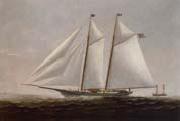 |
Charles S.Raleigh -- Click Here
|
|
English-born American, 1830-1925 |
|
|
|
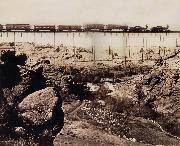 |
Charles Roscoe Savage -- Click Here
|
|
1832-1909, He was a British-born landscape and portrait photographer who produced images of the American West. He is best known for his 1869 photographs of the linking of the first transcontinental railroad. Savage was born in Southampton, England, on August 16, 1832. At age 14, he joined The Church of Jesus Christ of Latter-day Saints (LDS Church). After serving missions for the church in Switzerland and England, he emigrated to the United States during the winter of 1855?C56. He initially found work as a photographer in New York City, and headed west the following year. He first settled in Nebraska, then Council Bluffs, Iowa, where he established his first independent studio and gallery. In the spring of 1860, he traveled to Salt Lake City, Utah Territory with his family, where he established a photography studio with a partner, Marsena Cannon, an early Utah daguerreotypist and photographer. A year later, after Cannon moved to southern Utah, Savage established a partnership with artist George Ottinger. Many of Savage's photographs were reproduced in Harper's Weekly newspaper, which created a national reputation for the firm. This partnership continued until 1870. As a photographer under contract with the Union Pacific Railroad, Savage traveled to California in 1866 and then followed the rails back to Utah. He photographed the linking of the Union Pacific and Central Pacific on Promontory Summit, at Promontory, Utah in 1869 |
|
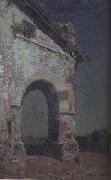 |
Charles Rollo Peters -- Click Here
|
|
born in San Francisco in 1862 ,dead 1928 |
|
 |
Charles Robert Leslie -- Click Here
|
|
1794 - 1859
was born in London on 19 October 1794. His parents were American, and when he was five years of age he returned with them to their native country. They settled in Philadelphia, where their son was educated and afterwards apprenticed to a bookseller. He was, however, mainly interested in painting and the drama, and when George Frederick Cooke visited the city he executed a portrait of the actor from recollection of him on the stage, which was considered a work of such promise that a fund was raised to enable the young artist to study in Europe. He left for London in 1811, bearing introductions which procured for him the friendship of West, Beechey, Allston, Coleridge and Washington Irving, and was admitted as a student of the Royal Academy, where he carried off two silver medals. At first, influenced by West and Fuseli, he essayed high art, and his earliest important subject depicted Saul and the Witch of Endor; but he soon discovered his true aptitude and became a painter of cabinet-pictures, dealing, not like those of David Wilkie, with the contemporary life that surrounded him, but with scenes from the great masters of fiction, from Shakespeare and Cervantes, Addison and Moli??re, Swift, Sterne, Fielding and Smollett. Of individual paintings we may specify Sir Roger de Coverley going to Church (1819); May-day in the Time of Queen Elizabeth (1821); Sancho Panza and the Duchess (1824); Uncle Toby and the Widow Wadman (1831); La Malade Imaginaire, act iii. sc. 6 (1843); and the Dukes Chaplain Enraged leaving the Table, from Don Quixote (1849). Many of his more important subjects exist in varying replicas. He possessed a sympathetic imagination, which enabled him to enter freely into the spirit of the author whom he illustrated, a delicate perception for female beauty, an unfailing eye for character and its outward manifestation in face and figure, and a genial and sunny sense of humour, guided by an instinctive refinement which prevented it from overstepping the bounds of good taste. In 1821 Leslie was elected A.R.A., and five years later full academician. In 1833 he left for America to become teacher of drawing in the military academy at West Point, but the post proved an irksome one, and in some six months he returned to England. |
|
 |
Charles Ricketts -- Click Here
|
|
1866-1931
English painter, designer, writer and collector. He trained as an illustrator at the City and Guilds Technical Art School, Lambeth, London, where he met and formed a lifelong relationship with CHARLES HAZELWOOD SHANNON. He identified with the ideals of the Aesthetic Movement, finding inspiration in Renaissance art as well as in the French artists Gustave Moreau and Pierre Puvis de Chavannes. In 1888 he took over James Abbott McNeill Whistler's house, The Vale, in Chelsea and drew together an artists' colony. Inspired by the work of A. H. Mackmurdo and William Morris, he set up a small press over which he exercised complete control of design and production, producing art journals and books that included Oscar Wilde's A House of Pomegranates (1891) and The Sphinx (1894). Ricketts later designed founts, initials, borders and illustrations for the Vale Press (1896-1904), blending medieval, Renaissance and contemporary imagery. |
|
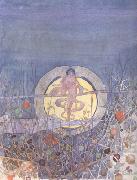 |
Charles Rennie Mackintosh -- Click Here
|
|
Scottish Art Nouveau Designer, 1868-1928
Scottish architect, designer and painter. In the pantheon of heroes of the Modern Movement, he has been elevated to a cult figure, such that the importance of his late 19th-century background and training in Glasgow are often overlooked. He studied during a period of great artistic activity in the city that produced the distinctive GLASGOW STYLE. As a follower of A. W. N. Pugin and John Ruskin, he believed in the superiority of Gothic over Classical architecture and by implication that moral integrity in architecture could be achieved only through revealed construction. Although Mackintosh's buildings refrain from overt classicism, they reflect its inherent discipline. His profound originality was evident by 1895, when he began the designs for the Glasgow School of Art. His decorative schemes, particularly the furniture, also formed an essential element in his buildings. During Mackintosh's lifetime his influence was chiefly felt in Austria, in the work of such painters as Gustav Klimt and such architects as Josef Hoffmann and Joseph Maria Olbrich. The revival of interest in his work was initiated by the publication of monographs by Pevsner (1950) and Howarth (1952). The Charles Rennie Mackintosh Society was formed in Glasgow in 1973; it publishes a biannual newsletter, has a reference library and organizes exhibitions. |
|
 |
Charles Rennie Macintosh -- Click Here
|
|
Scottish Art Nouveau Designer , (1868-1928).
Scottish architect, designer and painter. In the pantheon of heroes of the Modern Movement, he has been elevated to a cult figure, such that the importance of his late 19th-century background and training in Glasgow are often overlooked. He studied during a period of great artistic activity in the city that produced the distinctive GLASGOW STYLE. As a follower of A. W. N. Pugin and John Ruskin, he believed in the superiority of Gothic over Classical architecture and by implication that moral integrity in architecture could be achieved only through revealed construction. Although Mackintosh's buildings refrain from overt classicism, they reflect its inherent discipline. His profound originality was evident by 1895, when he began the designs for the Glasgow School of Art. His decorative schemes, particularly the furniture, also formed an essential element in his buildings. During Mackintosh's lifetime his influence was chiefly felt in Austria, in the work of such painters as Gustav Klimt and such architects as Josef Hoffmann and Joseph Maria Olbrich. The revival of interest in his work was initiated by the publication of monographs by Pevsner (1950) and Howarth (1952). The Charles Rennie Mackintosh Society was formed in Glasgow in 1973; it publishes a biannual newsletter, has a reference library and organizes exhibitions. The Hunterian Art Gallery, University of Glasgow, which opened in 1981, |
|
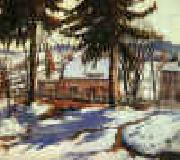 |
Charles Reiffel -- Click Here
|
|
1862-1942
Charles Reiffel Gallery |
|
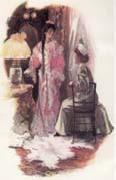 |
Charles M.Relyea -- Click Here
|
|
American, 1863-1932 |
|
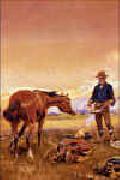 |
Charles M Russell -- Click Here
|
|
American Painter, 1864-1926
American painter and sculptor. In 1880 he left his upper-class home in St Louis for Montana Territory. He worked briefly on a sheep ranch, spent two years as a hunter's and trapper's assistant and then became a cowboy. During his considerable spare daytime hours he painted, sketched and modelled small animal figures in clay (e.g. Antelope, 1915; Fort Worth, TX, Amon Carter Mus.). Although he painted a few exceptional oils and watercolours prior to 1900, the vast majority of his best work was done in the last two decades of his life. Typically the subject-matter centres around cowboy life (e.g. Wagon Boss, 1909; Tulsa, OK, Gilcrease Inst. Amer. Hist. & A.) and the Plains Indians, for whom he had great respect. The luminous Piegans (1918; Denver, CO, Mus. W. A.), with its depiction of the Plains Indians, is a reminder of the vastness of the American West. Russell's sense of humour and empathy for his subject-matter radiates from his paintings as pleasingly as do the clear colours of the high country. His bronze sculptures (e.g. Buffalo Hunt, 1905; Denver, CO, Mus. W. A.) depict the same dramatic and tension-packed themes as his paintings. |
|
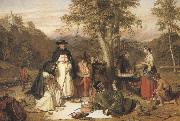 |
Charles landseer,R.A. -- Click Here
|
|
1799-1879
Painter, brother of Thomas Landseer. He trained initially with his father John Landseer, then under Benjamin Robert Haydon, and in 1816 he attended the Royal Academy Schools in London. In 1823 he accompanied Sir Charles Stuart de Rothesay (1779-1845) aboard HMS Wellesley on a voyage to Portugal and then to Brazil, in order to negotiate a commercial treaty with Pedro I, Emperor of Brazil (reg 1822-31). Many of the drawings he made on this trip were exhibited in 1828 at the British Institution, and in that year he sent his first painting to the Royal Academy. This was Dorothea, illustrating a scene from Cervantes's Don Quixote. He continued to exhibit at the Academy until his death, showing mostly romanticized history paintings or such literary subjects as Clarissa Harlowe in the Sponging House from Samuel Richardson's novel Clarissa (London, 1748). The English Civil War (1642-51) was of particular interest to him, his devotion to such historical subjects perhaps being attributable to the influence of his years with Haydon. He also painted portraits, genre scenes and animal studies . In 1837 he was elected ARA and in 1845 RA. In 1851, probably due to the influence of his brother Edwin, he succeeded George Jones as Keeper of the Royal Academy Schools. Responsible for instructing the antique class, his tenure was criticized both for the way his position had been obtained and for the deficiency of his teaching, and he retired from the Keepership in 1873 on full salary. |
|
|
|
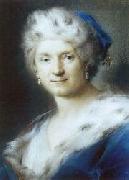 |
CARRIERA, Rosalba fg -- Click Here
|
|
Italian Rococo Era Painter, 1675-1757
|
|
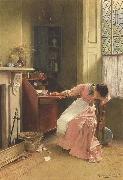 |
Carlton Alfred Smith,RI,RWS -- Click Here
|
|
fl.1871-1916
|
|
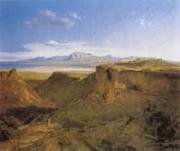 |
Carl Rottmann -- Click Here
|
|
German,1797-1850
was a German landscape painter and the most famous member of the Rottmann family of painters. Rottmann belonged to the circle of artists around the Ludwig I of Bavaria, who commissioned large landscape paintings exclusively from him. He is best known for mythical and heroising landscapes. The landscape painter Karl Lindemann-Frommel belonged to his school. Carl Anton Joseph Rottmann was born in Handschuhsheim (today a part of Heidelberg) on January 11, 1797. There he received his first drawing lessons from his father, Friedrich Rottmann, who taught drawing at the university in Heidelberg. In his first artistic period he painted atmospheric phenomena. In 1821 he moved to Munich, where his second period began, and in 1824 he married Friedericke, the daughter of his uncle, Friedrich Ludwig von Sckell, who served as an attendant at court. This connection cleared the way for an acquaintance with King Ludwig, who in 1826-27 sponsored his travels in Italy in order to widen his repertoire, which up to that point consisted solely of domestic, German, landscapes. Upon his return he received from King Ludwig I a commission for a monumental cycle of Italian landscapes in the arcade of the Munich Hofgarten. The cycle, completed in 1833 in fresco, gave visual expression to Ludwiges alliance with Italy, and raised the genre of landscape painting to the height of history painting, the preferred mode of the Kinges other great commissions for monumental painting. |
|
|
|
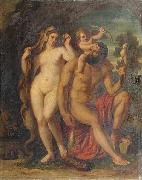 |
Carl Rahl -- Click Here
|
|
Carl Rahl, sometimes spelled Karl Rahl (13 August 1812 - 9 July 1865), was an Austrian painter.
Rahl was born in Vienna to Carl Heinrich Rahl (1779 - 1843), an engraver. He attended the Academy of Fine Arts Vienna and won a prize at the age of 19. From there he traveled to Munich, Stuttgart, Hungary, and in 1836 to Italy. He remained in Italy from 1836 to 1843, where he in particular studied representatives of the Venetian and Roman schools of art, and painted die Auffindung von Manfreds Leiche (1836).
Rahl's style, especially his views on color and perspective, were largely formed during his years in Rome. He returned after 1843 to Vienna for two years, and then led an itinerant life for the next five years, traveling through Holstein, Paris, Rome, Copenhagen, and Munich, making a living as a portrait painter. In this period he painted Manfreds Einzug in Luceria (1846), and die Christenverfolgung in den Katakomben.
In 1850, he was appointed professor at the Academy of Fine Arts Vienna, but for political reasons he was soon dismissed from the position. He then opened a private art school, which expanded quickly into a studio that produced monumental-scale paintings and enjoyed considerable success. He was commissioned by Greek philanthropist Simon Sinas to paint a number of works for the facade and vestibule of Vienna's Fleischmarkt Greek Church (Ludwig Thiersch being commissioned for the remainder of the frescoes), which was then being rebuilt by architect Theophil Freiherr von Hansen. In addition, Sinas commissioned four paintings depicting heroes of the Greek War of Independence, and a further four paintings to decorate his residence.
Rahl decorated the Heinrichshof in 1861 with personifications of Art, Friendship, and Culture, and the Palais Todesco with representations from the mythology of Paris. In 1864, he painted a number of allegorical figures in the stairway of the Waffenmuseum (now part of the Kunsthistorisches Museum). In this period he also painted several frescoes: Mädchen aus der Fremde (in a villa of Gmunden), a composition for a ballroom of a palace in Oldenburg, and a cycle from the tale of the Argonauts. Also, he painted the tympanum of the Athens Academy building, designed by Theophil von Hansen in 1859 and executed by Ernst Ziller (completed in 1885), and paintings in the portico of the Athens university, designed by Christian Hansen (Theophil Hansen's son). The central painting show Bavarian king Otto I surrounded by the Muses; the left hand fresco shows Prometheus bringing fire down from Mount Olympus. |
|
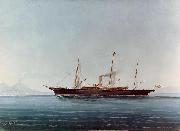 |
Campin, Robert, Follower of -- Click Here
|
|
Italian, 1400s |
|
 |
Camille Roqueplan -- Click Here
|
|
Camille Joseph Etienne Roqueplan, 18 February 1802 in Mallemort; † 30 September 1855 in Paris) was a French painter.
|
|
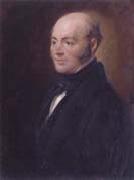 |
C.R. Leslie -- Click Here
|
|
English genre painter , 1794-1859
was an American artist best known for his cartoons and caricatures of actors and other celebrities. Though his work was heavily in demand through the 1920s and is often considered to epitomize the era, his personal life was troubled by mental illness, and he was nearly forgotten soon after his suicide, shortly before his fortieth birthday. English genre painter, was born in London on 19 October 1794. His parents were American, and when he was five years of age he returned with them to their native country. They settled in Philadelphia, where their son was educated and afterwards apprenticed to a bookseller. He was, however, mainly interested in painting and the drama, and when George Frederick Cooke visited the city he executed a portrait of the actor from recollection of him on the stage, which was considered a work of such promise that a fund was raised to enable the young artist to study in Europe. He left for London in 1811, bearing introductions which procured for him the friendship of West, Beechey, Allston, Coleridge and Washington Irving, and was admitted as a student of the Royal Academy, where he carried off two silver medals. At first, influenced by West and Fuseli, he essayed high art, and his earliest important subject depicted Saul and the Witch of Endor; but he soon discovered his true aptitude and became a painter of cabinet-pictures, dealing, not like those of David Wilkie, with the contemporary life that surrounded him, but with scenes from the great masters of fiction, from Shakespeare and Cervantes, Addison and Moliere, Swift, Sterne, Fielding and Smollett. Of individual paintings we may specify Sir Roger de Coverley going to Church (1819); May-day in the Time of Queen Elizabeth (1821); Sancho Panza and the Duchess (1824); Uncle Toby and the Widow Wadman (1831); La Malade Imaginaire, act iii. sc. 6 (1843); and the Dukes Chaplain Enraged leaving the Table, from Don Quixote (1849). |
|
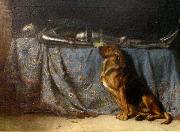 |
Briton Riviere -- Click Here
|
|
(14 August 1840 C 1920) was an Irish artist born in London, England.
His father, William Riviere, was for some years drawing-master at Cheltenham College, and afterwards an art teacher at Oxford University. He was educated at Cheltenham College and at Oxford, where he took his degree in 1867. For his art training he was indebted almost entirely to his father, and early in life made for himself a place of importance among the artists of his time.
His first pictures appeared at the British Institution, and in 1857 he exhibited three works at the Royal Academy, but it was not until 1863 that he became a regular contributor to the Academy exhibitions. In that year he was represented by "The Eve of the Spanish Armada", and in 1864 by a "Romeo and Juliet". Subjects of this kind did not, however, attract him long, for in 1865 he began, with a picture of a "Sleeping Deer-hound", a series of paintings of animal-subjects which later occupied him almost exclusively.
|
|
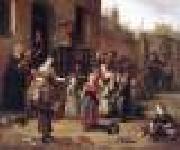 |
BRAKENBURG, Richard -- Click Here
|
|
Dutch painter (b. 1650, Haarlem, d. 1702, Haarlem) |
|
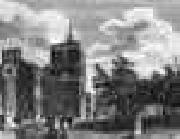 |
Birch, William Russell -- Click Here
|
|
American, 1755-1834 |
|
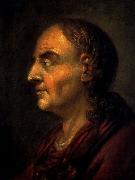 |
Bernhard Rode -- Click Here
|
|
Bernhard Rode (25 July 1725 - died 28 June 1797) was a Prussian artist and engraver well-known for portraying historical scenes and allegorical works. He knew most of the central figures in the Berlin Enlightenment as Friedrich Nicolai and Gotthold Lessing, and the philosophical and political discussions of the Berlin Philosophs informed much of the subject matter of his artistic work. His paintings include several works depicting, in various guises, the King of Prussia Frederick the Great, who ruled the Prussia during much of Rode's lifetime. Rode was director of the Berlin Academy of the Arts from 1783 until his death in 1797.
Rode was the son of a goldsmith Christian Bernhard Rode and his wife, Anna Sophie. The copper engraver Johann Heinrich Rode and the sculptor Philipp Rode were his brothers. He received his earliest artistic training from his father and his earliest training in drawing from a painter, N. Meller. His four-year education at the studio of the court painter Antoine Pesne, an influential painter in Berlin and Brandenburg, was important to his professional development. During his apprenticeship, he learned to paint portraits. In 1748, Rode began a study trip of several years. He spent 18 months in the studio of Jean Restout and Charles Andre van Loo (sometimes known as Carle van Loo or Vanloo). He became acquainted with Jean-Baptiste Deshayes and developed his talent and interest in the medium of history painting. In Venice and Rome, he studied the old masters. In 1755 or 1756, he returned to Berlin, and he married Sophie Luise, but the earliest years of their marriage remained childless. |
|
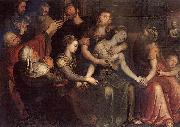 |
Bernaert de Ryckere -- Click Here
|
|
Bernaert de Rijckere (c1535, Kortrijk - 1590, Antwerp), was a Flemish Renaissance painter.
According to Karel van Mander he was born in Kortrijk and was admired there for an altarpiece depicting Christ bearing the cross, which he made for the St. Marten's church of the brothers of the Cross there. He later took on a different style that Karel van Mander had heard of but had not seen to be able to judge it for himself. He said he moved to Antwerp and joined the Guild of St. Luke there in 1561.
According to the Netherlands Institute for Art History he was the teacher of his son, the painter Abraham de Rijcke, and is known for landscapes and historical allegories. |
|
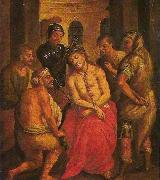 |
Bento Jose Rufino Capinam -- Click Here
|
|
painted Christ Wearing the Crown of Thorns in 1791-1874 |
|
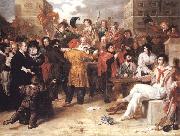 |
Benjamin Robert Haydon -- Click Here
|
|
English Romantic Painter, 1786-1846
1786-1846.was an English historical painter and writer. Haydon was born at Plymouth. His mother was the daughter of the Rev. Benjamin Cobley, rector of Dodbrooke, near Kingsbridge, Devon. Her brother, General Sir Thomas Cobley, was renowned for his part in the siege of Ismail. Benjamin's father, a prosperous printer, stationer and publisher, was well known in Plymouth. Haydon, an only son, at an early date showed an aptitude for study, which was carefully fostered by his mother. At the age of six he was placed in Plymouth grammar school, and at twelve in Plympton St Mary School, the same school where Sir Joshua Reynolds had received most of his education. On the ceiling of the school-room was a sketch by Reynolds in burnt cork, which Haydon loved to sit and look at. Whilst at school he had some thought of adopting the medical profession, but he was so shocked at the sight of an operation that he gave up the idea. Reading Albinus inspired him with a love for anatomy; but from childhood he had wanted to become a painter. Full of energy and hope, he left home, on 14 May 1804, for London, and entered the Royal Academy as a student. He was so enthusiastic that Henry Fuseli asked when he ever found time to eat. Aged twenty-one (1807) Haydon exhibited, for the first time, at the Royal Academy, The Repose in Egypt, which was bought by Thomas Hope the year after for the Egyptian Room at his townhouse in Duchess Street. This was a good start for the young artist, who shortly received a commission from Lord Mulgrave and an introduction to Sir George Beaumont. In 1809 he finished his well-known picture of Dentatus, which, though it increased his fame, resulted in a lifelong quarrel with the Royal Academy, whose committee had hung it in a small side-room instead of the great hall. That same year, he took on his first pupil, Charles Lock Eastlake, later destined to become one of the great figures of the British art establishment. In 1810 his financial difficulties began when the allowance of £200 a year from his father was stopped. His disappointment was embittered by the controversies in which he now became involved with Beaumont, for whom he had painted his picture of Macbeth, and Richard Payne Knight, who had denied the beauties as well as the money value of the Elgin Marbles. |
|
|
|
Bayeu, Ramn -- Click Here
|
|
Spanish Painter, 1746-1793 |
|
 |
Baron Jean-Baptiste Regnault -- Click Here
|
|
Paris 1754-1829
French painter. His first teacher was the history painter Jean Bardin, who took him to Rome in 1768. Back in Paris in 1772, he transferred to the studio of Nicolas-Bernard Lepicie. In 1776 he won the Prix de Rome with Alexander and Diogenes (Paris, Ecole N. Sup. B.-A.) and returned to Rome, where he was to spend the next four years at the Academie de France in the company of Jacques-Louis David and Jean-Francois-Pierre Peyron. While witnessing at first hand Peyron's development of a manner indebted to Poussin and David's conversion to Caravaggesque realism, Regnault inclined first towards a Late Baroque mode in a Baptism of Christ (untraced; recorded in two sketches and an etching), then, in Perseus Washing his Hands (1779; Louisville, KY, Speed A. Mus.), to the static Neo-classicism of Anton Raphael Mengs. |
|
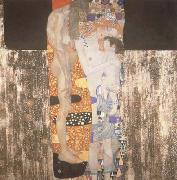 |
Auguste Rodin -- Click Here
|
|
French Sculptor, 1840-1917
.French sculptor. Insolvent and repeatedly rejected by the École des Beaux-Arts, he earned his living by doing decorative stonework. Not until his late 30s, after a trip to Italy, did he develop a personal style free of academic restraints and establish his reputation as a sculptor with The Age of Bronze (exhibited 1878), whose realism was so great that he was accused of forming its mold on a living person. His Gates of Hell, a bronze door commissioned in 1880 for a proposed Musee des Arts Decoratifs, remained unfinished at his death, but two of its many figures were the bases of his most famous images, The Thinker (1880) and The Kiss (1886). His portraits include monumental figures of Victor Hugo and Honore de Balzac. Though these and many other works caused controversy for their unconventionality, he was successful enough that he could establish a workshop where he executed only molds, leaving the casting of bronze and the carving of marble to assistants. To his sculpture he added book illustrations, etchings, and numerous drawings, mostly of female nudes. |
|
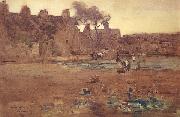 |
Arthur Melville,ARSA,RSW,RWS -- Click Here
|
|
1855-1904 |
|
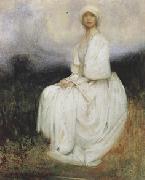 |
Arthur hacker,R.A. -- Click Here
|
|
1858-1919
was an English classicist painter. Born in London in 1858, Hacker was the son of Edward Hacker, a line engraver specialising in animal and sporting prints (who was also for many years the official Registrar of Births, Marriages and Deaths for Kentish Town in the St Pancras registration district, north London). In his art he was most known for painting religious scenes and portraits, and his art was also influenced by his extensive travels in Spain and North Africa. He studied at the Royal Academy between 1867 and 1880, and at the Atelier Bonnat in Paris. He was twice exhibited at the Royal Academy, in 1878 and 1910, and was elected an Academician in 1910. In 1894 he was the subject of a bust by Edward Onslow Ford. An original portrait by Hacker of Sir Alfred Keogh by hangs in the RAMC HQ Mess at Millbank, London. He died in London on November 12, 1919. In 1902, |
|
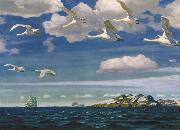 |
Arkady Rylov -- Click Here
|
|
(Russian: 29 January 1870 - June 22, 1939) was a Russian and Soviet Symbolist painter.
Rylov was born in the village Istobenskoye, Vyatka gubernia. He was brought in the family of his stepfather, a notary (Rylov's father had a psychiatric illness). He moved to Saint Petersburg and studied at the Technical Design School of Baron Schtiglitz (1888-1891), then at the Imperial Academy of Arts under Arkhip Kuindzhi (1894-1897).
Rylov was a member of the Mir iskusstva movement and its spin-off Union of Russian Artists also a member of the Association of Artists of the Revolutionary Russia. He was a chairman of the Kuindzhi Society.
He started as a historical painter (his graduation work in the Imperial Academy of Arts was Assault of Pechenegs on a Slav village but became a predominately landscape painter. Still many of his paintings have some allusions with Russian history.
Many of his landscapes painted after the October Revolution were seen as symbols of the revolutionary Freedom. At that time he also painted some typical Socialist Realism compositions like Lenin in Razliv. He taught in the Academy of Arts. In his studio he created almost a small nature reserve. There lived squirrels, rabbits, monkey Manka and many wild birds (without cages) and two anthills. According to Mikhail Nesterov wild animals and birds loved Rylov and often came to his studio.
|
|
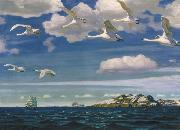 |
Arkady Alexandrovich Rylov -- Click Here
|
|
Arkady Alexandrovich Rylov (Russian, 29 January [O.S. 17 January] 1870 - June 22, 1939) was a Russian and Soviet Symbolist painter.
Biography
Rylov was born in the village Istobenskoye, Vyatka gubernia. He was brought in the family of his stepfather, a notary (Rylov's father had a psychiatric illness). He moved to Saint Petersburg and studied at the Technical Design School of Baron Schtiglitz (1888-1891), then at the Imperial Academy of Arts under Arkhip Kuindzhi (1894-1897).
In the Blue Expanse, 1918Rylov was a member of the Mir iskusstva movement and its spin-off Union of Russian Artists also a member of the Association of Artists of the Revolutionary Russia. He was a chairman of the Kuindzhi Society. |
|
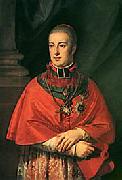 |
Archduke Rudolf of Austria -- Click Here
|
|
Rudolf Johannes Joseph Rainier von Habsburg-Lothringen, Archduke and Prince Imperial of Austria, Prince Royal of Hungary and Bohemia (8 January 1788 - 24 July 1831) was a Cardinal, an Archbishop of Olomouc, and a member of the House of Habsburg-Lorraine.
Born in Pisa, Italy, he was the youngest son of Emperor Leopold II and Maria Louisa of Spain. He was elected archbishop of Olomouc in 1819 and became cardinal in the year 1820.
In 1803 or 1804, Rudolf began taking lessons in piano and composition from Ludwig van Beethoven. The two became friends, and Rudolph became a supporter and patron of Beethoven; their meetings continued until 1824. Beethoven dedicated 14 compositions to Rudolph, including the Archduke Trio, the Hammerklavier Sonata, the Emperor Concerto and the Missa Solemnis. Rudolph, in turn, dedicated one of his own compositions to Beethoven. The letters Beethoven wrote to Rudolph are today kept at the Gesellschaft der Musikfreunde in Vienna.
On 24 March 1819 he was appointed, at the age of 31, Archbishop of Olomouc in the present day Czech Republic but then part of the Austrian Empire. He was made Cardinal-Priest of the titular church of S. Pietro in Montorio by Pope Pius VII on 4 June 1819. He was ordained a priest on 29 August 1819, and consecrated a bishop on 26 September.
In 1823 - 24, he was one of the 50 composers who composed a variation on a waltz by Anton Diabelli for Vaterländischer Kenstlerverein. In Rudolf's case, the music was published anonymously, as by "S.R.D" (standing for Serenissimus Rudolfus Dux).
|
|
|
|
|
|
 |
Antonio Rotta -- Click Here
|
|
painted L'enfant avec les raisins in 1884 |
|
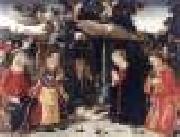 |
ANTONIAZZO ROMANO -- Click Here
|
|
[Italian Early Renaissance Painter, 1430-ca.1510
Antoniazzo was born in the Colonna quarter of Rome.
He was influenced at first by the decorative manner of Benozzo Gozzoli and Beato Angelico, as well as by the local painters of Lazio. His first recorded work is from 1461, a replica (untraced) of the miraculous Virgin and Child of St. Luke in the Basilica of Santa Maria Maggiore of Rome, for the seignior of Pesaro, Alessandro Sforza.
From 1464 he worked for the papal court, producing at first a triptych of the Virgin and Child with Saints in Rieti. In 1467 he completed the decoration of the funerary chapel of Cardinal Bessarion in the church of Santi Apostoli of Rome, not far from his birthplace. In the centre of the decoration was an icon of the Virgin, now in the Chapel of St Anthony, a copy of the Byzantine icon in the Santa Maria in Cosmedin, the church of the Greeks in Rome. This icon in the Santi Apostoli is one of the most remarkable examples of Antoniazzo's considerable production of Virgins, generally taken from Byzantine models: he was indeed a much sought-after copier of icons. Later he worked to a series of frescoes in the Monastery of Tor de' Specchi in Rome, featuring stories of the life of S. Francesca Romana, and to the decoration of the public rooms of the Palazzo Venezia.
In the 1470s Antoniazzo worked to the decoration of the Vatican Palace with artists like Perugino, Melozzo da Forl?? and Ghirlandaio. Through their influence his figures acquired gentler expressions and their garments were ornamented with decorative patterns, though always retaining several Medieval features.
Together with Melozzo he worked to frescoes in Santa Maria sopra Minerva, and subsequently painted for that church a famous Annunciation (1482). The painting shows the Dominican Juan de Torquemada (cardinal) (d. 1468) presenting poor girls dowered by the guild of the Annunciation that he founded to the Virgin Mary.
In the years between 1475 and 1480 Antoniazzo's production of altarpieces and panels with images of the Virgin increased as a result of the encouragement of the cult of the Virgin by Pope Sixtus IV. His later works show an increasing mannerism in their features, which were later imitated by several painters, whose works had been often attributed to the master.
Antoniazzo was one of the three founders of the Compagnia di San Luca, the guild of painters and illuminators in Rome, and signed the statutes in 1478. |
|
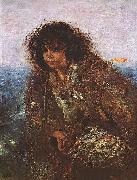 |
Anton Romako -- Click Here
|
|
(October 20, 1832 - March 8, 1889) was an Austrian painter.
Anton Romako was born in Atzgersdorf (now a district of Liesing, Vienna), as an illegitimate son of factory owner Josef Lepper and his housemaid Elisabeth Maria Anna Romako. He studied painting at the Academy of Fine Arts Vienna (1847-49) but his teacher, Ferdinand Georg Waldmeller, considered him talentless. Later, he studied in Munich (1849) under Wilhelm Kaulbach, and subsequently in Venice, Rome and London. In the early 1850s he studied privately in Vienna under Carl Rahl, whose style Romako adopted. In 1854 he began travels to Italy and Spain and in 1857 settled in Rome as the favourite portrait, genre, and landscape painter for the local colony of foreigners.
In 1862 Romako married Sophie Köbel, the daughter of architect Karl Köbel, and the pair had five children before Sophie left Romako in 1875 for her lover. In 1876 Romako returned to Vienna but failed to re-establish himself against the style representend by Hans Makart and increasingly relied on the charity of such wealthy patrons as Count Kuefstein. He made study trips to Hungary, Italy and France, and during the years 1882-84 he alternated between Paris and Geneva. Two daughters, Mathilde and Mary, committed suicide in 1887; Romako had never recovered from the shock. His last years were spent living in neglect near Vienna, where he died in poverty in 1889. Romako was buried at the Central cemetery in Vienna.
In 1953 a street in Atzgersdorf was named after the painter: Romakogasse. Anton Romako's painting "The battle of Lissa" was selected as a motive for a recent commemorative coin: the 20 euro S.M.S. Erzherzog Ferdinand Max minted on September 15, 2004.
His brother, Joseph von Romako, was a Naval Architect-Inspector of Austro-Hungarian Navy.
|
|
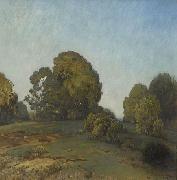 |
Anton Ritter von Stadler -- Click Here
|
|
painting Landschaft in 1909 |
|
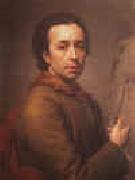 |
Anton Raphael Mengs -- Click Here
|
|
1728-1779
Dutch
Anton Raphael Mengs Gallery
Mengs was born in 1728 at Usti nad Labem (German: Aussig) in Bohemia on 12 March 1728; he died in Rome 29 June 1779. His father, Ismael Mengs, a Danish painter, established himself finally at Dresden, whence in 1741 he took his son to Rome.
In Rome, his fresco painting of Parnassus at Villa Albani gained him a reputation as a master painter. The appointment of Mengs in 1749 as first painter to Frederick Augustus, elector of Saxony did not prevent his spending much time in Rome, where he had married Margarita Quazzi who had sat for him as a model in 1748, and abjured the Protestant faith, and where he became in 1754 director of the Vatican school of painting, nor did this hinder him on two occasions from obeying the call of Charles III of Spain to Madrid. There Mengs produced some of his best work, and specially the ceiling of the banqueting-hall of the Royal Palace of Madrid, the subject of which was the Triumph of Trajan and the Temple of Glory. Among his pupils there was Agust??n Esteve. After the completion of this work in 1777, Mengs returned to Rome, and there he died, two years later, in poor circumstances, leaving twenty children, seven of whom were pensioned by the king of Spain. His portraits and autoportraits recall an attention to detail and insight, often lost from the grand manner paintings.
Besides numerous paintings in the Madrid gallery, the Ascension and St Joseph at Dresden, Perseus and Andromeda at Saint Petersburg, and the ceiling of the Villa Albani must be mentioned among his chief works. In 1911, Henry George Percy, 7th Duke of Northumberland, possessed a Holy Family, and the colleges of All Souls and Magdalen, at Oxford, possessed altar-pieces by Mengs's hand.
In his writings, in Spanish, Italian and German, Mengs has put forth his eclectic theory of art, which treats of perfection as attainable by a well-schemed combination of diverse excellences Greek design, with the expression of Raphael, the chiaroscuro of Correggio, and the colour of Titian. He would have fancied himself the first neoclassicist, while in fact he may be the last flicker of Baroque art. Or in the words of Wittkower, In the last analysis, he is as much an end as a beginning.
His intimacy with Johann Joachim Winckelmann, who constantly wrote at his dictation, has enhanced his historical importance, for he formed no scholars, and the critic must now concur in Goethe's judgment of Mengs in Winckelmann und sein Jahrhundert; he must deplore that so much learning should have been allied to a total want of initiative and poverty of invention, and embodied with a strained and artificial mannerism.
Mengs was famous for his rivalry with the contemporary Italian painter Pompeo Batoni. |
|
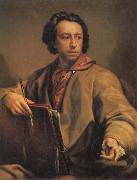 |
Anton Raffael Mengs -- Click Here
|
|
a pastel portrait painter
German,1728-1779
|
|
|
|
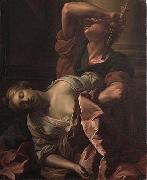 |
Antoine Rivalz -- Click Here
|
|
(1667, Toulouse - 1735) was a French painter. The son of Jean-Pierre Rivalz (who painted and designed the city's hôtel de ville), Antoine was the official painter to the town of Toulouse, a talented portraitist of the society of the city in the 18th century. He also produced a large number of drawings.
Antoine Rivalz began his training in the studios of his father Jean-Pierre, the sculptor Marc Arcis and the artist Raymond Lafage. In his training, he was particularly interested in studying classical works and the Baroque Italian masters. From 1685 to 1687 he trained at the Academie royale de peinture et de sculpture in Paris. On his return to Toulouse he received his first two commissions. In 1687 he set out for Rome, where he stayed for more than ten years. In 1694 he won second prize at the Accademia di San Luca with a drawing of The fall of the giants, with first prize going to Antonio Balestra and Felice Nardi. In Rome he became friends with other artists such as Carlo Maratta, Luigi Garzi and Benedetto Luti, and was more and more in demand for commissions from families in both Rome and Toulouse.
In 1703, he returned to Toulouse and was made painter of the city's hôtel de ville, a post he held until his death. Supported by an important studio, he received a large number of commissions - commemorative paintings, paintings of ordinance and armour, architectural projects, restorations. This post, however, allowed him above all to forge productive relations with the city's upper classes and benefit from a near-monopoly on public, religious and private commissions in the city.
He married his first cousin Louise Rivalz, with whom he had six children, including the future artist Pierre Rivalz, known as the "chevalier Rivalz". In 1726 he set up Toulouse's first art school and in 1750 letters patent from Louis XV turned it into the Academie royale de peinture et de sculpture de Toulouse, the only one in France (after that in Paris) to be allowed to bear that title.
|
|
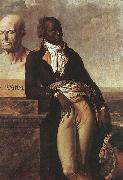 |
Anne-Louis Girodet de Roussy-Trioson -- Click Here
|
|
(also given as Anne-Louis Girodet de Roucy-Triosson, Anne-Louis Girodet-Trioson) January 5, 1767 - December 9, 1824), was a French painter and pupil of Jacques-Louis David, who was part of the beginning of the Romantic movement by adding elements of eroticism through his paintings. Girodet is remembered for his precise and clear style and for his paintings of members of the Napoleonic family.
|
|
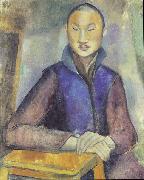 |
Anita Ree -- Click Here
|
|
painted Young Chinese man in 1919 |
|
 |
Andrei Ryabushkin -- Click Here
|
|
(Russian:29 October [O.S. 17 October] 1861 - 10 May [O.S. 27 April] 1904) was a Russian painter. His major works were devoted to life of ordinary Russians of the 17th century.
Andrey Petrovich Ryabushkin was born in the village Stanichnaya sloboda, Borisoglebskiy uezd, Tambov gubernia in 1861. His father and brother were icon painters, and he started to help them from his early childhood. At 14 years old he became an orphan. A student of Moscow School of Painting, Sculpture and Architecture A. Kh. Preobrazhensky, who spent the summer in the village, happened to see the boyes drawings and was greatly impressed by them. He started to give him lessons and helped him to enter the Moscow School of Painting, Sculpture and Architecture. Ryabushkin was one of the youngest student of the school at all times.
Ryabushkin stayed for seven years (1875-82) in the Moscow School, learning from Vasily Perov and Illarion Pryanishnikov. His first large work Peasant Wedding was bought by Pavel Tretyakov in 1880. After the death of Vasiliy Perov, Ryabushkin moved to Saint Petersburg in 1882, and entered the Imperial Academy of Arts where he learned from Pavel Chistyakov. The classes soon disappointed him, however, and he began to spend more and more time either in the library of the academy or sketching in the streets.
His studies at the academy came to an end in 1892. He did not receive an award for his diploma work, Descent from the Cross, as was expected, because he did not follow the approved project. But the work was so good that the president of the academy, Grand Duke Vladimir Konstantinovich, provided Ryabushkin with a stipend for travel and studies abroad from his own means. Instead of going to Italy or Paris, Ryabushkin chose to make a tour of ancient Russian towns (Novgorod, Kiev, Moscow, Uglich, Yaroslavl). The inhabitants of them became his first models and his first critics. |
|
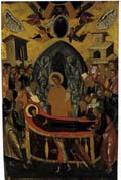 |
Andreas Ritzos -- Click Here
|
|
Greek Byzantine Style Painter, 1422-1492 |
|
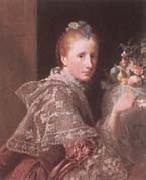 |
Allan Ramsey -- Click Here
|
|
1713-1784
Rococo,Scottish |
|
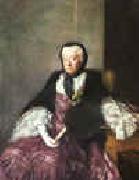 |
Allan Ramsay -- Click Here
|
|
1713-1784
British Allan Ramsay Galleries
Allan Ramsay was born in Edinburgh, Scotland, the eldest son of Allan Ramsay, poet and author of The Gentle Shepherd.
Ramsay's first wife, Anne Bayne, by Ramsay
Ramsay's second wife Margaret Lindsay, by RamsayFrom the age of twenty he studied in London under the Swedish painter Hans Huyssing, and at the St. Martin's Lane Academy; leaving in 1736 for Rome and Naples, where he worked for three years under Francesco Solimena and Imperiali (Francesco Fernandi). On his return in 1738 he first settled in Edinburgh, attracting attention by his head of Duncan Forbes of Culloden and his full-length portrait of the Duke of Argyll, later used on Royal Bank of Scotland banknotes. He later moved to London, where he was employed by the Duke of Bridgewater. His pleasant manners and varied culture, not less than his artistic skill, contributed to render him popular. His only serious competitor was Thomas Hudson, with whom he shared a drapery painter, Joseph van Aken. In 1739 he married his first wife, Anne Bayne, the daughter of a professor of Scots law at Edinburgh, Alexander Bayne of Rires (c.1684?C1737), and Mary Carstairs (1695??C1759). None of their 3 children survived childhood, and she died on 4 February 1743 giving birth to the third of them.
One of his drawing pupils was Margaret Lindsay, eldest daughter of Sir Alexander Lindsay of Evelick and Amelia Murray (granddaughter to David Murray, 5th Viscount of Stormont and sister to the naval officer John Lindsay). He later eloped with her and on 1 March 1752 they married in the Canongate Kirk, Edinburgh, though her father never forgave her for marrying an artist. Ramsay already had to maintain a daughter from his previous marriage as well as his two surviving sisters, but told Sir Alexander that he could provide Margaret with an annual income of £100 which would increase ??as my affairs increase, and I thank God, they are in a way of increasing?? and that his only motive for the marriage was ??my love for your Daughter, who, I am sensible, is entitled to much more than ever I shall have to bestow upon her??. There were three surviving children from their long and happy marriage, Amelia (1755?C1813), Charlotte (1758?C1818?), and John (1768?C1845).
Ramsay and his new wife spent 1754?C1757 together in Italy, going to Rome, Florence, Naples and Tivoli, researching, painting and drawing old masters, antiquities and archaeological sites, and (to earn an income) painting Grand Tourists' portraits. This and other trips to Italy involved more literary and antiquarian research than art. After their return, he was in 1761 appointed to succeed John Shackelton as Principle Painter in Ordinary to George III, beating Hudson to the post; and so fully employed was he on the royal portraits which the king was in the habit of presenting to ambassadors and colonial governors, that he was forced to take advantage of the services of a host of assistants--of whom David Martin and Philip Reinagle are the best known.
He gave up painting in about 1770 to concentrate on literary pursuits, his health shattered by an accidental dislocation of the right arm and his second wife's death in 1782. With unflinching pertinacity, he struggled until he had completed a likeness of the king upon which he was engaged at the time, and then started for his beloved Italy, leaving behind him a series of fifty royal portraits to be completed by his assistant Reinagle. For several years he lingered in the south, his constitution finally broken. He died at Dover on 10 August 1784. |
|
|
|
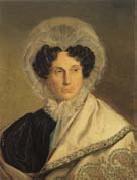 |
Alfred Rethel -- Click Here
|
|
1816 Diepenbend/Aachen-1859 Dusseldorf, was a German history painter. Rethel was born in Aachen in 1816. He showed an interest in art in his early life, and at the age of thirteen he executed a drawing which procured his admission to the academy of D??sseldorf. Here he studied for several years, and produced, among other works, a figure of St Boniface, which attracted much attention. At the age of twenty, Rethel moved to Frankfurt, and was selected to decorate the walls of the imperial hall in the Rmer with figures of famous men. At the same period he produced a series of designs illustrative of Old Testament history. Four years later, Rethel was the successful competitor for the work of ornamenting the restored council house of his native city with frescoes depicting prominent events in the career of Charlemagne, but the execution of this work was delayed for some six years. Meanwhile Rethel occupied himself with the production of easel pictures and of drawings. In 1842, he began a striking series of designs dealing with the Crossing of the Alps by Hannibal, in which the weird power which animates his later art becomes first apparent. In 1844 Rethel visited Rome, executing, along with other subjects, an altar-piece for one of the churches of his native land. In 1846, he returned to Aachen, and commenced his Charlemagne frescoes. |
|
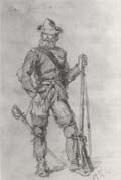 |
Alfred R. Waud -- Click Here
|
|
American, 1828-1891,was an American artist and illustrator, born in London, England. He is most notable for the sketches he made as an artist correspondent during the American Civil War. Before emigration, Alfred Waud had entered the Government School of Design at Somerset House, London, with the intention of becoming a marine painter. This did not come to fruition, but as a student, he also worked as a painter of theatrical scenery. He intended to pursue that work in the United States, when he immigrated in 1850, seeking employment with actor and playwright John Brougham. In the 1850s, he worked variously as an illustrator for a Boston periodical, the Carpet-Bag, and provided illustrations for books such as Hunter's Panoramic Guide from Niagara to Quebec (1857). The period during the American Civil War was time when all images in a publication had to be hand drawn and engraved by skilled artist. Photography existed but there was no way to transfer a photograph to a printing plate since this was well before the advent of the halftone process for printing photographs. Photographic equipment was too cumbersome and exposure times were to slow to be used on the battlefield. An artist such as Waud would do detailed sketches in the field, which were then rushed by courier back to the main office of the newspaper they were working for. There a staff of engravers would use the to sketches create finished engravings for publication. In 1860 Alfred Waud became an illustrator or special artist (a full time paid staff artist) for the New York Illustrated News. In April 1861, the newspaper assigned Waud to cover the Army of the Potomac, Virginia main Union army. He first illustrated General Winfield Scott in Washington, D.C., and then entered the field to render the First Battle of Bull Run in July. Waud followed a Union expedition to Cape Hatteras, North Carolina the next month. That autumn, he sketched army activity in the Tidewater region of Virginia. Waud joined Harper's Weekly toward the end of 1861, continuing to cover the war. In 1864 Alfred brother, William Waud (who up to that time had been working with Frank Leslie Illustrated Newspaper), joined Alfred on the staff of Harper's and they worked together during the Petersburg Campaign. Alfred Waud attended every battle of the Army of the Potomac between the First Battle of Bull Run in 1861 and the Siege of Petersburg in 1865. Alfred was one of only two artists present at the Battle of Gettysburg. His depiction of Pickett Charge is thought to be the only visual account by an eyewitness. Waud died in 1891 in Marietta, Georgia, while touring battlefields of the South. |
|
|
|
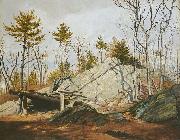 |
Alexandre Rachmiel -- Click Here
|
|
painted Autumn Landscape in 1890 |
|
 |
Alexandre N. Roussoff -- Click Here
|
|
Russian, 1844 - 1928 |
|
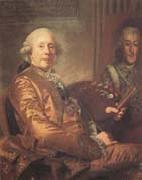 |
Alexander Roslin -- Click Here
|
|
1718--93
Swedish painter and pastellist, active in Germany and France. He trained with Lars Ehrenbill (1697-1747), a draughtsman employed by the Admiralty in Malmö, and in Stockholm under Georg Engelhardt Schräder (1684-1750), a portrait painter working in the tradition of Hyacinthe Rigaud and Nicolas de Largillierre. In 1741 Roslin moved to Göteborg, but the following year he returned to Malmö, where he executed devotional works for the parish church of Hasslöv, Halland, and began establishing himself as a portrait painter. |
|
|
|
|
| | |
|
|
|
|